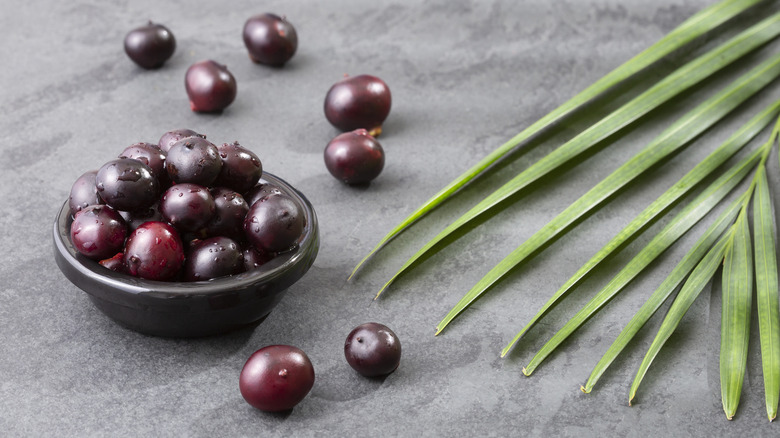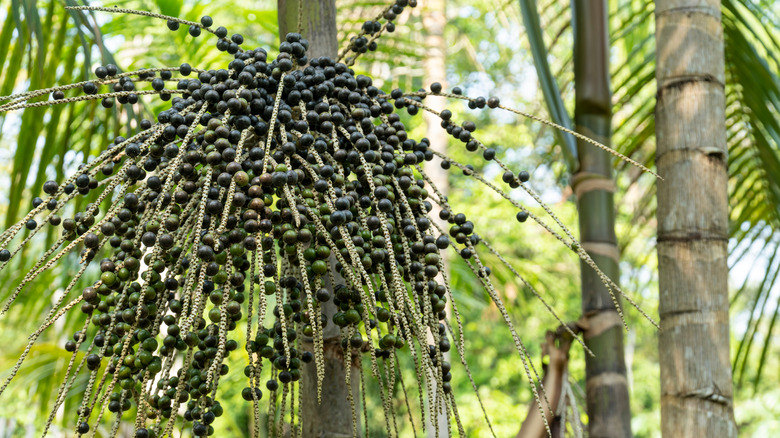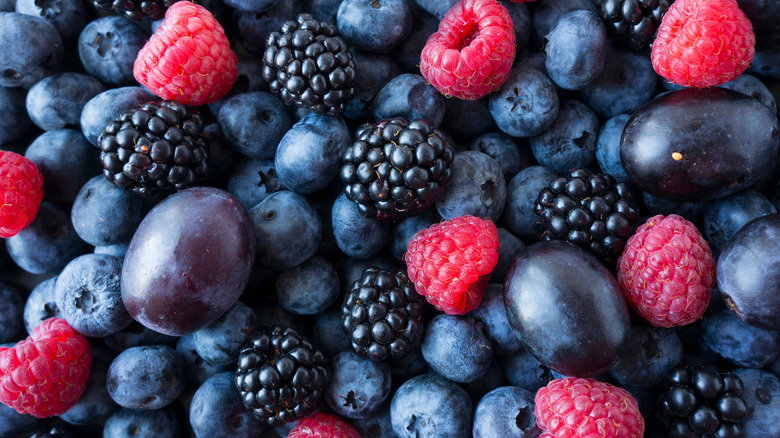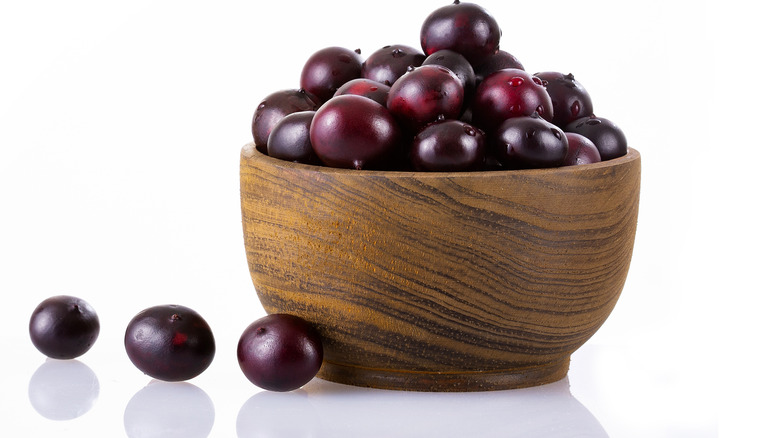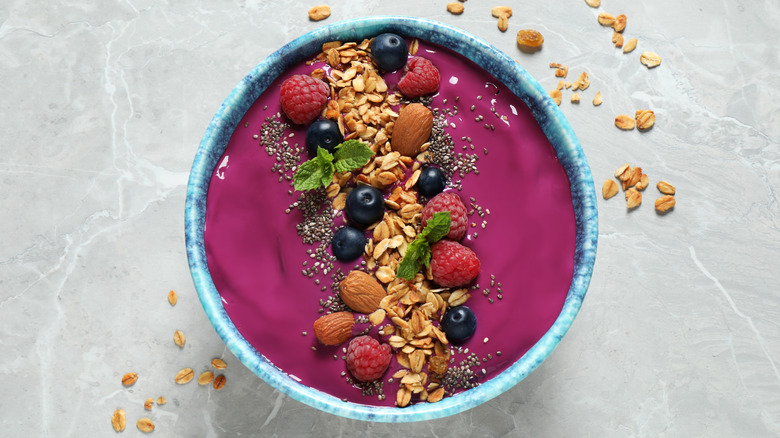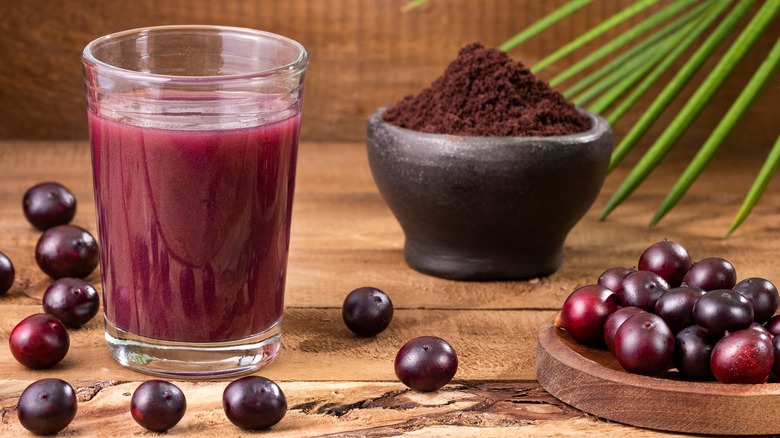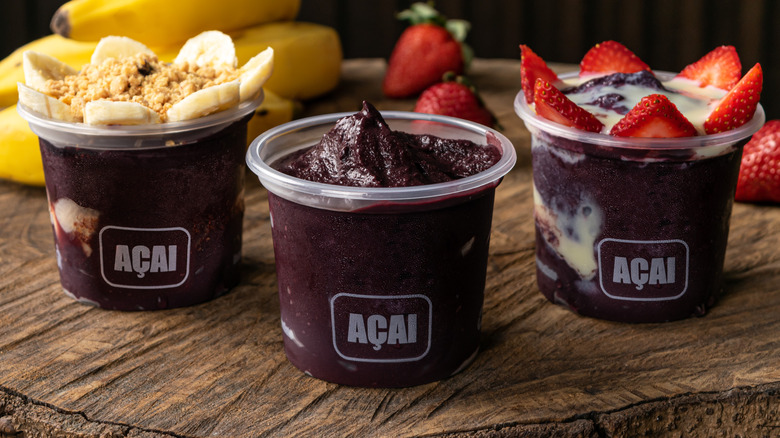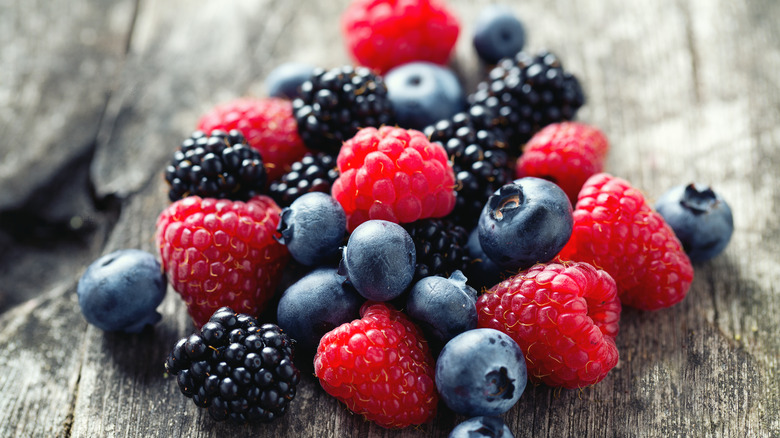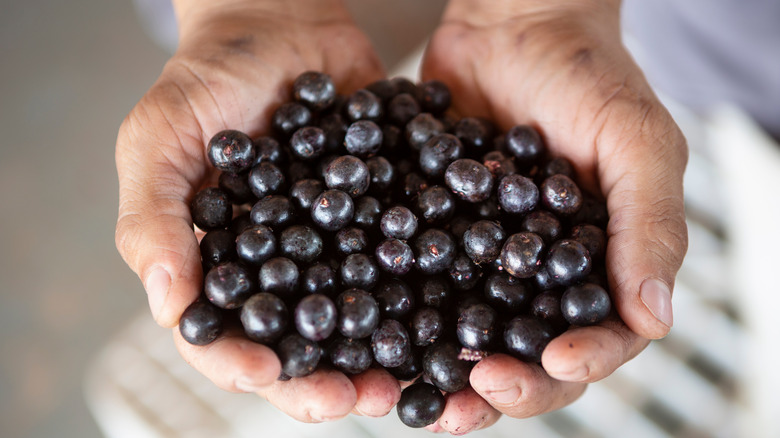What Is Açai And Is It Really A Superfood?
Over the last few years, there's been a massive boom in health foods and, more specifically, superfoods. From chia seeds, avocado, spirulina, and quinoa, to kale, ginger, edible seaweed, and rolled oats — the list is endless. Recently, açaí (Euterpe oleracea) has been having its own moment in the sun among superfood enthusiasts. Whether it's in the form of juice, powder, or frozen, it's been touted as the ultimate addition to your smoothies. According to the American Botanical Council, the word açaí is actually a made-up European word based on the Tupian word "ïwasa'i." Oh, and if you're wondering how to pronounce it, you're not alone — it's AH-sigh-EE.
Per All About Palm Trees, açaí trees are a member of the palm family; they can be identified by their long, slim trunks and leaves that resemble feathers, and usually produce blackish-purple, single-seeded berries about five years after planting. If you've ever been curious about its supposed wonders, look no further. Below is a one-stop guide for everything you need to know about açaí. From its origins, taste, and how you can incorporate it into your cooking, down to its nutritional value, where to buy it, and whether or not it's really a superfood — let's talk all things açaí.
What are the origins of açaí?
While açaí's spelling and pronunciation may be fun, you will find that its origins are what make it truly special. According to the American Botanical Council, even though açaí originated in Brazil, Columbia, and Suriname, it was among Amazonian tribes (where the trees are most heavily concentrated) that it came to be known as a form of medicine. The Saramaccan Maroon people would wrap açaí tree leaves around the necks of babies in order to protect them from evil, as well as to help them grow. Among the Shuar people, medicine men and women, known as uwishin, would administer açaí berries for its antioxidant properties and to manage cholesterol.
Additionally, among Peruvian Amazonian people, the açaí root would be made into a tea that was given for the treatment of a range of diseases, including anemia, diabetes, dysmenorrhea, and malaria, among others. In fact, while açaí may be a nifty addition to morning smoothies in the U.S. and other parts of the world, per Organic Facts, it can make up almost a quarter of some Amazonian people's total food intake within a single day.
Açaí berries versus blackberries
Usually likened to goji berries, blueberries, and cranberries, açaí berries are, per Nutritionist Answers, most similar to blackberries — at least where color and flavor profile are concerned. Besides that, they are quite different. According to Garden Guides, unlike açaí berries, which are grown from palm trees that flourish in warmer climates and produce fruit after about five years, blackberries are grown on hardy bushes that can thrive even under cold weather conditions and fruit after about two years.
In addition, while both berries are often sought out for their similar antioxidant properties and flavors, the culinary uses for which they are chosen can be entirely unique. For instance, while açaí berries may be used as flavoring in spirits, specifically vodka and tequila, blackberries are used to flavor wine. Interestingly though, if you need an açaí powder substitute in a smoothie, smoothie bowl, or a frozen dessert, blackberries are especially great given the sweet but tart flavor, and, of course, the rich color.
What does açaí taste like?
Seeing as açaí berries tend to attract people who enjoy blackberries, what is it that these two berries share in terms of flavor profiles? According to Clean Juice, açaí berries are known and mostly appreciated for a flavor profile that blends both sweet and tartness. Further, per Love To Know, some of the words that can be attributed to the taste of açaí berries include, rich, grainy, tropical, refreshing, and bitter.
Maybe surprisingly, because açaí berries are often consumed as powders, purées, and juices that likely contain other ingredients, most people may not know that açaí berries also have aftertaste notes that are reminiscent of dark chocolate. Seemingly, these dark notes may in some part be due to the polyphenols contained in açaí berries. This is because those polyphenols are also found in cocoa beans, hence the similarity.
How to cook with açaí
One of the things that people often look forward to discovering about an ingredient that is hailed as a superfood is its capacity to be versatile. Fortunately, the açaí berry can stand its own in this regard. Listed among some of the absolute best ways to use açaí — beyond the obvious smoothie — are pairing it with your oatmeal, whether it's cooked on the stove, in the microwave, or prepared overnight. You can also boil down one part cane sugar, one part açaí berries, and one part water to make a syrup. The possibilities of how to use the syrup are endless; whether you substitute it in other dishes that call for syrup, as a topping, or mixed into alcoholic beverages.
On the note of alcoholic beverages, you can substitute your post work glass of wine for a mojito using rum, or, if you're feeling more adventurous, tequila. Add to that some açaí purée, mint, or other herbs, a bit of lime, and top it all off with some club soda. If you're more of a snacker, you could even make ancient energy bites using açaí powder, a nut butter, and agave syrup, with some added crunch from granola, coconut, and cacao nibs.
Where to buy açaí
With the current boom in the popularity of açaí, it's become more and more accessible for purchasing. As such, it really comes down to what is most convenient and cost effective for you. According to Nutritionist Answers, in 2022, some of the açaí brands you could find on the market included Açaí Roots, Amazon Planet, Pitaya Foods, Sambazon, Simply Nature, and even Trader Joe's. Each brand offered its own range of açaí-based products. For instance, Amazon Planet sells frozen açaí packs, while the range at Açaí Roots includes powders and juices, as well as ready-made kombucha and snack bars.
Some of the chain outlets you could purchase these brands from are Target, Walmart, Whole Foods, and Trader Joe's. If you prefer online shopping, Açaí Roots is your go-to. Currently, a case of 64 açaí purée pouches is priced at around $100 at, and this includes shipping. It's organic, sustainably-sourced, and comes out to less than $2 per pouch.
Nutritional information of açaí
According to Healthline, açaí berries' nutrition profile is especially impressive because, not only do they pack about three times more antioxidants than blueberries, they are also high in healthy fats and low in sugar. Additionally, the Shuar medicine men and women were definitely onto something, as several animal studies and one human study have reportedly found that consuming açaí berries may lower the presence of "bad" cholesterol in the body.
Further, açaí berries may also be good for the largest organ on the human body: the skin. Per Nourish by WebMD, because the antioxidants contained in açaí oil do not decrease after it's been processed, one can continue to reap its benefits by way of skin and hair products that contain it — from face and body lotion, right down to your shampoo and conditioner. Despite all this, while açaí berries may hardly have any drawbacks, the most important one to watch out for is assuming that it's the alpha and omega of all health. As with all foods, it remains important to maintain an overall balanced and healthy diet that incorporates a wide range of foods.
Other varieties of açaí
While açaí berries that most people are familiar with are blackish-purple in color, there are five other variants to be aware of, namely: açu' açaí, white açaí berries, oxblood açaí berries, açaí chumbinho, and sword açaí berries. Açu' açaí are native to the Peruvian Amazon and tend to be much larger, hence the name which translates to "big açaí." White açaí berries, more popularly called açaí tinga among the Pará people, are quite rare and therefore much more expensive than the classic variant. Interestingly, even though they are called white açaí berries, their peels are often some shade of green.
Named for its deep red color, oxblood açaí berries are barely eaten due to their pungent flavor and texture. Açaí chumbinho and sword açaí berries are named for their tiny size and shape, respectively. Ultimately though, the blackish-purple açaí berry remains much more popular than its counterparts because its combination of nutrients and flavor profile trumps the others. If you want substitutes that also offer a good balance of nutrition and taste, per Tastylicious, cranberries, goji berries, pomegranates, acerolas, and blueberries are your best bet.
Why is it a superfood?
In addition to having high levels of antioxidants, omegas, and aiding in the control of cholesterol, per HealthifyMe, açaí berries may also support brain function, help to regulate glucose levels, and prevent some forms of cancer. Although some of the health benefits of açaí berries cannot be denied, and while they can be enjoyed in various forms and dishes, the need for more research into many of these claims is needed. As always, it remains vital to reiterate the importance of not overestimating the benefits of superfoods. Açaí berries are not exempt from this.
As previously noted, no one ingredient can be the be-all end-all of health and wellness. Instead, the ultimate health and wellness first prize will always be to have a balanced diet, consistent movement practices, and all the other things health professionals have always — and continue — to recommend. That being said, there is certainly no drawback to adding açaí to your diet.
